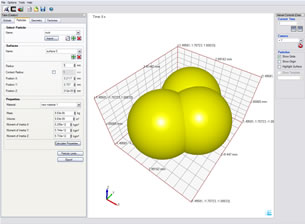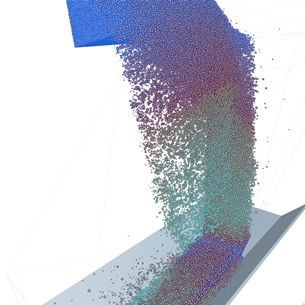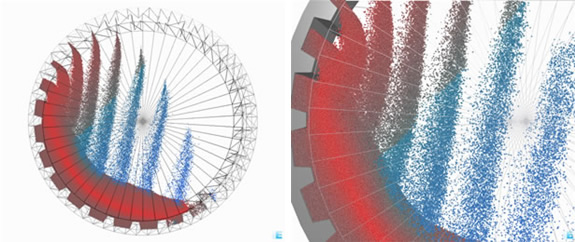Latest News
May 7, 2008
By DE Editors
 Creating your particles in EDEM. |
DEM Solutions (Edinburgh, Scotland & Lebanon, NH) has released version 2.0 of EDEM, its discrete element method (DEM) modeling software for simulating, analyzing, and optimizing particles in motion, particle-handling systems, and the complex interactions of particles moving in bulk with equipment and surrounding media. A faster solver supporting up to 8 CPUs in a multicore computing workstation, improved visualization performance, and built-in video generation are among the major enhancements in version 2. EDEM 2.0, notes the company, is the first commercial DEM solution that is able to simulate more than one million particles on a desktop engineering workstation.
In related news, DEM Solutions announced that it will collaborate with scientists and engineers at NASA’s Kennedy Space Center (KSC) to add new modeling capabilities to EDEM that will enable NASA’s Dust Mitigation and In-Situ Resource Utilization (ISRU) programs to model the unique physical and electrostatic characteristics of lunar and Martian dust and rock (regolith) in the design of new technologies for dust mitigation, and excavation, handling and processing of granular material under low gravity conditions.
DEM Solutions describes EDEM as a “multi-purpose” DEM tool to contrast EDEM’s task flexibility to point solutions developed by industry and government as well as to highlight the software’s ease of use for non-experts and experts alike. Running under Windows or Linux and adhering to the familiar user interface conventions of these operating systems, EDEM empowers any engineer to leverage DEM solvers to model, simulate, visualize, and analyze particulates as varied as dust, soil, rocks, and bottles to solve engineering problems relating to aggregate segregation, granulation, mixing dynamics, and surface coating.
“EDEM 2.0 is another milestone in the development of DEM as a key tool to help engineers solve critical particle handling and processing problems,” said John Favier, CEO of DEM Solutions, in a statement to the press. “It is highly parallelized and is capable of simulating systems containing over a million particles using standard desktop multi-processor hardware. This release will enable our customers to increase their productivity and the scale of applications they can address using EDEM.”
|
EDEM 2.0’s data input screens let you create a parameterized model of your granular solids system quickly and easily. You can import CAD models of real particles to obtain an accurate representation of their shape and, unlike most DEM applications that mandate spherical shapes, EDEM allows shapes to be irregular. It also accepts mixed sizes and shapes, such as nut, pea, and or stove coal. You can store data on mechanical, material, and other physical properties that form your model particles in a library for later re-use, enabling you to build a knowledge base unique to your processes. EDEM imports MCAD geometry of your equipment as well. Supported imported formats include IGES, STEP, Pro/E, Fluent Mesh, ACIS, Parasolid, CATIA v5, and ANSYS.
EDEM has three components: EDEM Creator, EDEM Simulator, and EDEM Analyst. Creator provides the tools for importing MCAD geometry or CAE files and defining geometry kinematics, materials, and particle shapes. Additionally, its Particle Body Force interface lets you apply body forces, including fluid drag, electrostatic, and electromagnetic forces, to a particle or component element.
“EDEM 2.0 is another milestone in the development of DEM as a key tool to help engineers solve critical particle handling and processing problems. It is highly parallelized and is capable of simulating systems containing over a million particles using standard desktop multi-processor hardware.” |
Efficient detection of contact between discrete objects is a key feature of Simulator, EDEM’s discrete element solver. Newly parallelized to support up to 8 CPUs in a multicore engineering workstation, Simulator’s toolkit of mechanical contact models include bonded particle, cohesion, conveyor, Hertz-Mindlin, linear spring, and moving surface. You can write out results at pre-determined intervals and watch its run-time visualizations to identify trends and correct problems quickly. Simulator is also customizable for user-defined processes.
EDEM Analyst, the postprocessor, contains a variety of tools for visualizing and graphing any combination of variables. Features include 3D visualization with pan and zoom, built-in video generation from rendered images at each time-step, plotting of primary data and user-defined parametric data, population-based spatial analysis, particle tracking, vector plots, and contact and structure visualization. Data can be exported to ASCII and other formats.
 EDEM can be used to simulate systems with more than 1 million particles. Here a conveyor transport simulation with 1 million particles is shown. The particle buildup and segregation on the conveyor can be analyzed by EDEM and the conveyor belt speed can be varied accordingly. |
Further, EDEM 2.0 produces results that can be used with continuum solvers such as FEM, CFD, and EMAG to analyze particle-structure, particle-fluid, and particle-EMAG interactions. EDEM has formal couplings with FLUENT and EASY5. The EDEM-FLUENT coupling module, for example, is a full two-way coupling that provides plug-and-play DEM co-simulation ability within FLUENT.
Because of its new support for desktop multiprocessor computers, existing EDEM users will find that version 2.0 lets them visualize models with great amounts of particles and that additional render-quality options provide more detailed analyses.
Additional enhancements to EDEM 2.0 include a new compact file format approximately 10x more compact than earlier versions of the software. Visualizations are said to be about 10x faster than before. The ability to generate images and videos of simulations is now built-in to EDEM.
EDEM version 2.0 runs under 32-/64-bit Windows XP or Linux (Suse or Red Hat). Recommended specifications include 4GB of RAM and 64-bit AMD Opteron or Intel Xeon processors with 256MB RAM or better GeForce 6 series or Radeon 9800 graphics. 500MB is required to install EDEM, with a minimum of 500GB recommended for storing simulations and videos.
The new contract with NASA will continue the enhancement EDEM software to meet NASA’s advanced modeling needs in particle electrostatics and interactions with electric and magnetic fields as well as handling and processing of lunar regolith. DEM Solutions engineers will contribute to the Dust Mitigation program, which is developing technologies for removal of dust from lunar equipment.
“We are delighted to be continuing our collaboration with NASA and contributing to development of technologies in support of their lunar program,” said John Favier.
Go directly to the DEM Solutions web page.
Why DE’s editors chose EDEM 2.0 as a Pick of the Week.
More information about the EDEM.
Access a video library of EDEM action.
Read about the DEM Solutions and NASA collaboration.
Read about the DEM Solutions and NASA collaboration on DE.
Information about the Electrostatics and Surface Physics Laboratory at the NASAKennedy SpaceCenter.
Subscribe to our FREE magazine, FREE email newsletters or both!
Latest News
About the Author
DE’s editors contribute news and new product announcements to Digital Engineering.
Press releases may be sent to them via [email protected].







